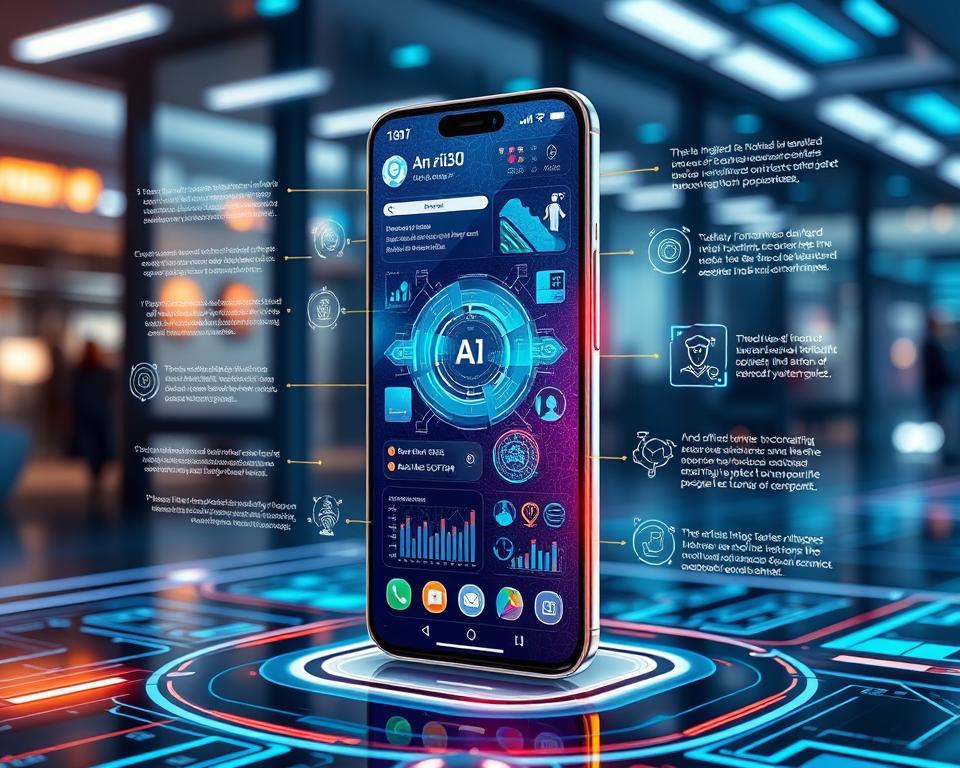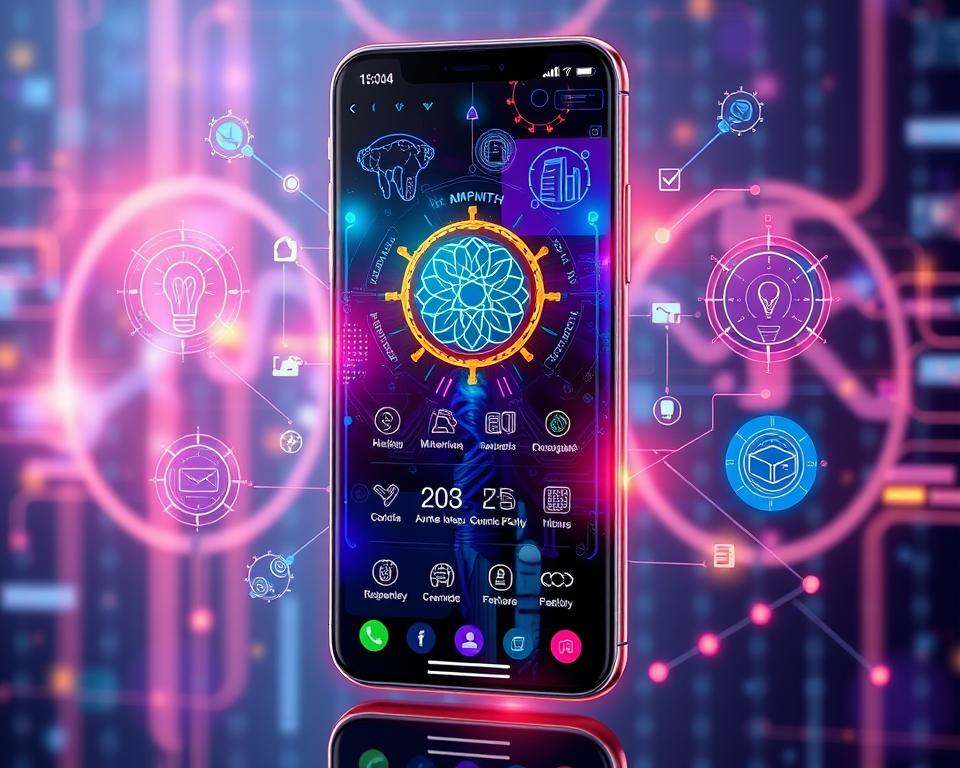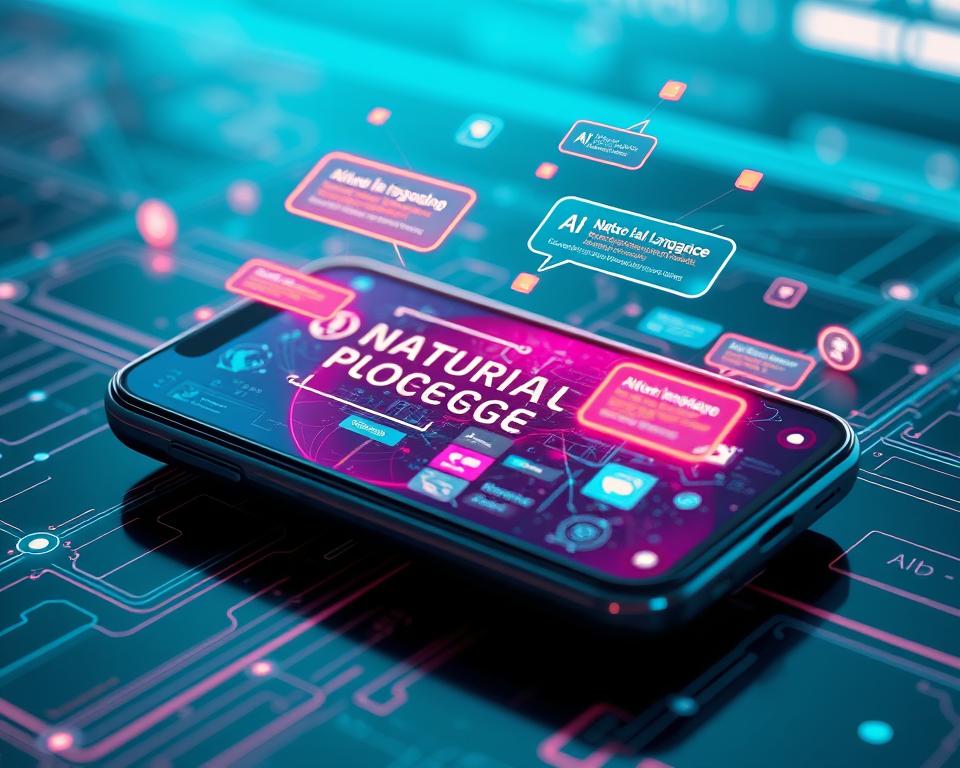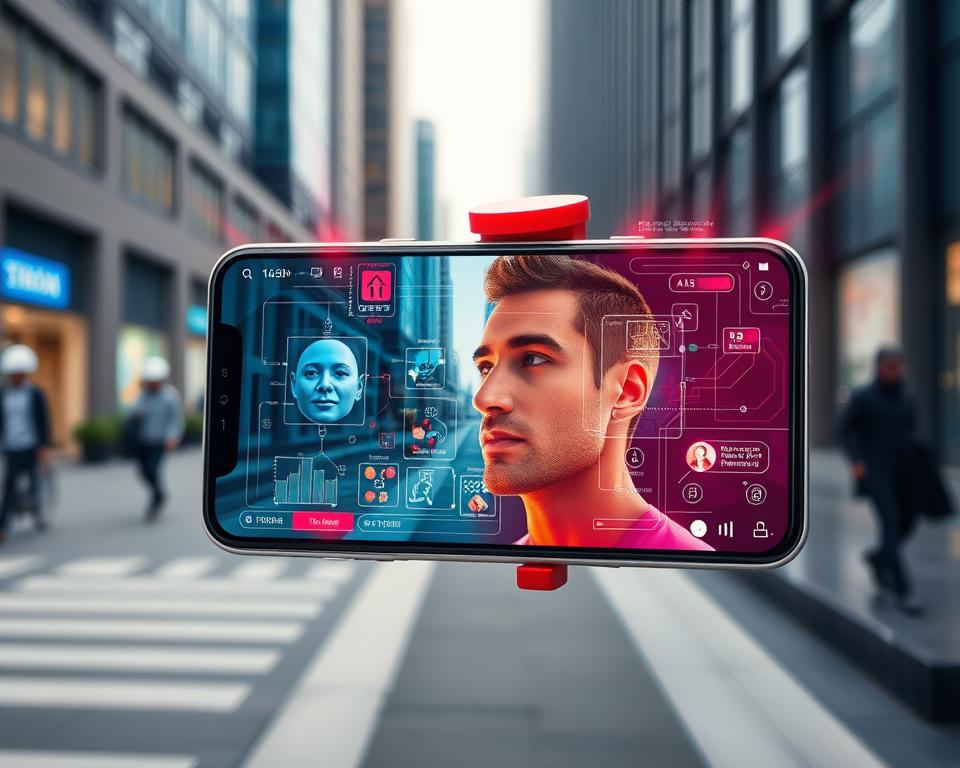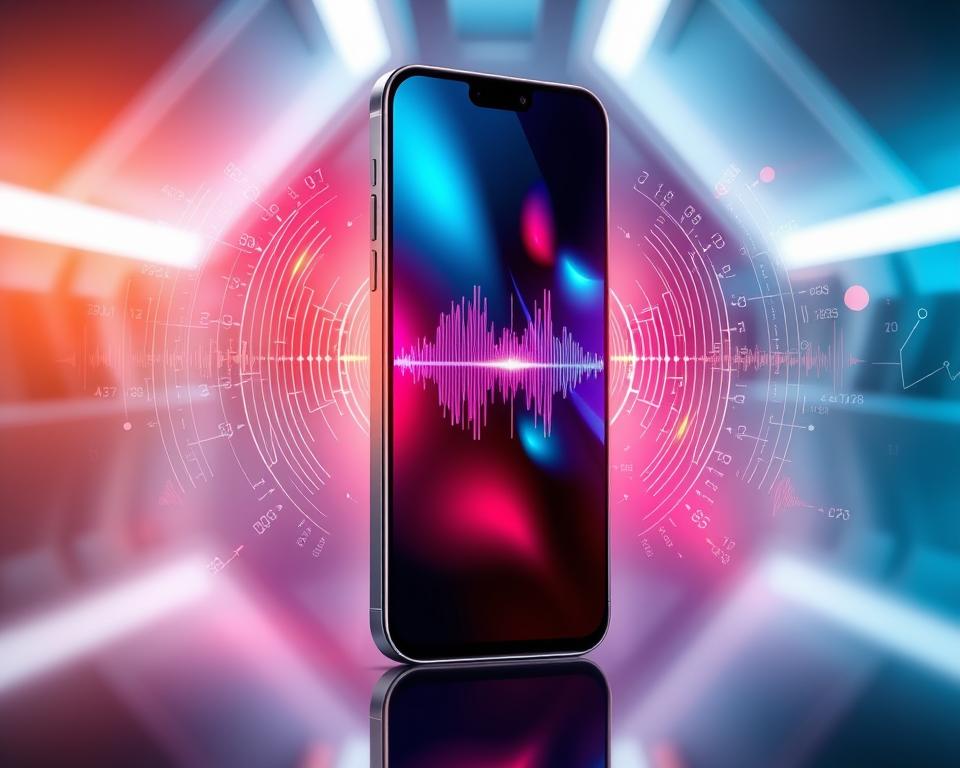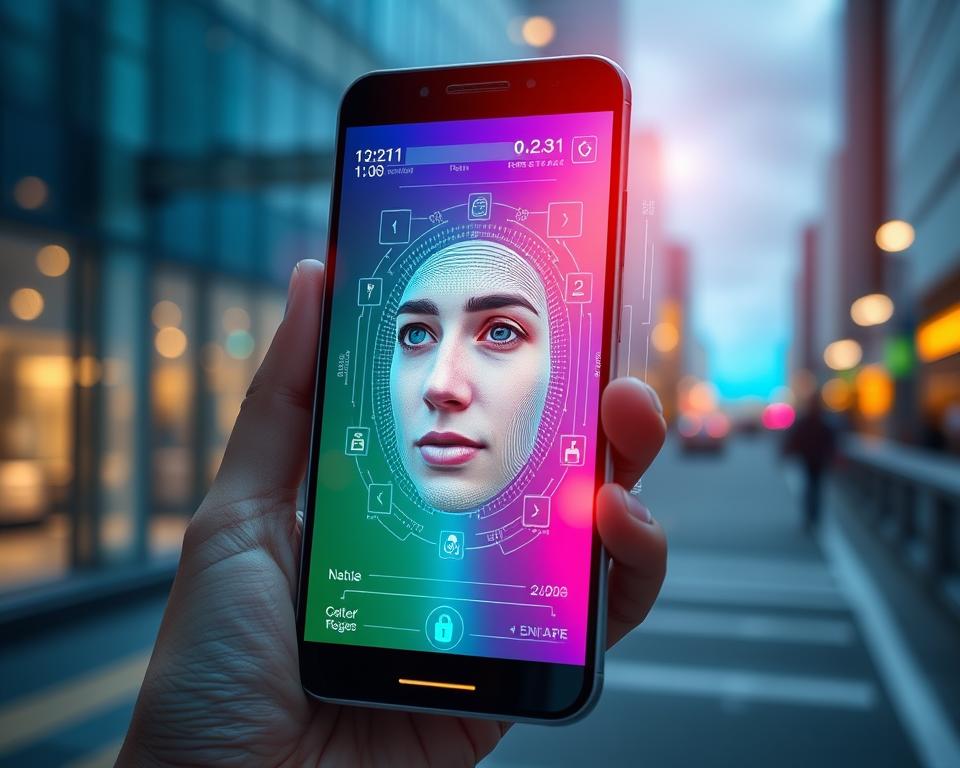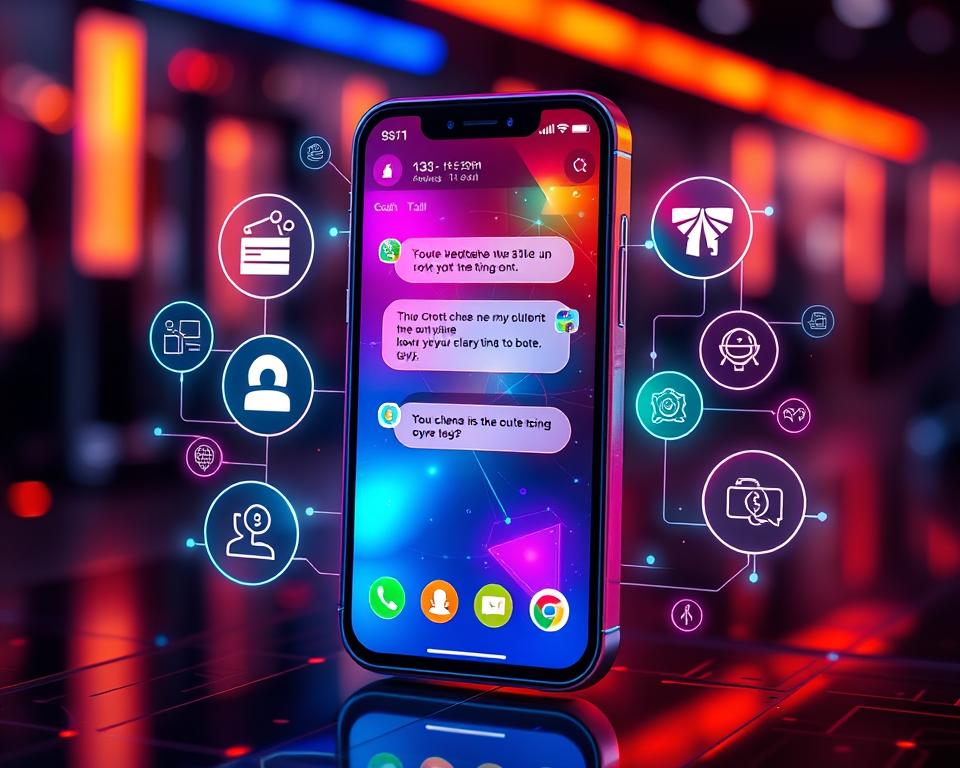The mobile app world is changing fast, thanks to AI. AI apps are making our experiences better and more fun. They use cool tech like natural language and computer vision to change how we use apps.
We’ll look at the top AI tech for mobile apps. We’ll see how AI makes apps better and what’s popular now. We’ll also talk about cool AI features like talking to apps and recognizing voices. These features make apps more useful and fun to use.
Table of Contents
Key Takeaways
- Discover the latest AI-powered features transforming mobile app experiences
- Understand the core AI technologies driving innovation in mobile development
- Explore the benefits of integrating AI capabilities into mobile applications
- Analyze the current market trends and adoption of AI in the mobile industry
- Learn how to leverage cutting-edge AI features to enhance your mobile app’s functionality
Understanding AI Integration in Modern Mobile Apps
Mobile app development is changing fast, thanks to AI integration. This change is making apps better and more fun for users. New AI technologies are leading this change.
Core AI Technologies in Mobile Development
Machine learning in apps, natural language processing, and computer vision are key. These technologies help apps understand what users want. They can even recognize images and understand spoken words.
Benefits of AI Implementation
- Personalized user experiences through intelligent recommendations and predictive analytics
- Improved productivity and efficiency through automation and task optimization
- Enhanced security and fraud detection capabilities
- Real-time insights and decision-making support
Current Market Trends
The mobile app development world is seeing more AI features. Big tech companies and new startups are using AI. They’re adding features like virtual assistants, chatbots, and smart search.
As the market grows, using AI integration wisely will set apps apart. Developers can make apps that really connect with users.
Natural Language Processing Capabilities for Mobile Apps
Mobile devices are getting smarter, thanks to natural language processing (NLP). NLP in mobile apps lets users analyze text, detect feelings, and understand language better. This changes how we talk to our phones.
The app Google Translate is a great example of NLP in action. It uses NLP and language understanding to translate text in over 100 languages. This makes talking to people from different countries easy.
Grammarly is another app that uses NLP. It checks your writing as you go, helping you write clearly and correctly. It suggests grammar fixes and tone changes, making writing better with NLP in mobile apps.
The future of mobile apps looks bright with more NLP. Advances in language understanding and text analysis will bring new ways to use our phones. As technology improves, NLP will make our phones smarter and more personal.
“NLP in mobile apps is revolutionizing the way we interact with our devices, empowering users with intelligent text analysis and language understanding capabilities.”
Machine Learning Models in Mobile Applications
The mobile world is changing fast, with machine learning (ML) playing a big role. ML models give mobile devices smart powers. They help make apps that use artificial intelligence (AI) right on your phone. Let’s explore the types of ML models and how they help in mobile app development.
Supervised Learning Applications
Supervised learning is a key ML method. It trains models on labeled data for predictions. In mobile apps, it’s used for tasks like image recognition and text scanning.
For example, a mobile app can use it to identify plants or animals. It can also scan images to translate text or recognize characters.
Unsupervised Learning Implementation
Unsupervised learning helps apps find hidden patterns in data. It’s great for mobile machine learning tasks like user segmentation and content personalization. Developers use it to create user profiles and suggest products.
It also improves the app’s user experience.
Real-time Model Training
Real-time model training is a big deal in mobile ML. It lets apps learn and adapt to users’ habits. This means better, more personal experiences without needing the internet all the time.
Tools like TensorFlow Lite make it easy to update ML models on the device. This opens up new possibilities for smart mobile apps.
As mobile tech grows, ML will be key in shaping app futures. By using supervised, unsupervised learning, and real-time training, developers can make apps that truly engage users. This drives innovation in the mobile world.
Computer Vision Features for Enhanced User Experience
In the world of mobile apps, mobile computer vision has changed the game. It opens up new ways to make user experiences better. With image recognition and object detection, these technologies are changing how we use our phones.
Image recognition is a big part of this. Mobile apps can now look at images and find things like objects, faces, and text. This lets users easily search for things, translate text, or find products just by taking a photo.
- Effortless object detection lets users quickly find and interact with items around them.
- Augmented reality (AR) uses computer vision to add digital stuff to the real world. It makes experiences more fun and real.
- Facial recognition and biometric authentication make apps more secure. They let users safely get into their devices and apps.
Thanks to strong libraries and APIs, developers can add these mobile computer vision features to apps easily. This makes apps more user-friendly and exciting.
“The future of mobile apps is all about combining the latest tech like computer vision and image recognition. These features are changing how we use our phones. They’re making our experiences more intuitive and fun.”
As people want better mobile experiences, mobile computer vision and object detection will be key. They will help shape the future of mobile apps.
Voice Recognition and Speech Processing Integration
In the world of mobile apps, voice recognition and speech processing have changed how we use them. These AI features make using apps easier and more natural. They meet our need for quick and hands-free ways to interact with devices.
Voice Command Systems
Voice command systems are a big step forward. They use mobile voice recognition to let users control apps with their voice. You can start apps, set reminders, and find info just by talking.
Speech-to-Text Capabilities
Speech-to-text is another key feature. It lets users type by speaking. This makes it easier to write messages, documents, or search the web without typing.
Multilingual Support Features
Thanks to voice assistants and speech processing, apps now support many languages. Users can switch languages easily and have their voice commands understood. This makes apps more accessible and inclusive worldwide.
The need for easier, hands-free app use is growing. Voice recognition and speech processing will keep being important in app development. These AI technologies help make mobile experiences more engaging and user-focused.
Predictive Analytics in Mobile Applications
In the fast-changing world of mobile tech, predictive analytics is becoming key. It helps make user experiences better and gives insights from data. By using data from mobile devices, developers can predict what users will do next. This lets them offer content that fits what users like, keeping them happy and interested.
At the core of mobile predictive analytics is understanding user behavior. Mobile apps use smart algorithms to guess what users will do next. This means they can show users things they’ll find useful, making the app better and giving insights for future improvements.
| Key Benefits of Predictive Analytics in Mobile Apps | Examples |
|---|---|
| Personalized Content Recommendations | Suggesting products, articles, or services based on user’s browsing history and preferences |
| Predictive Maintenance and Troubleshooting | Anticipating device or app issues and proactively addressing them before they occur |
| Targeted Marketing and Promotions | Delivering personalized offers and campaigns based on user segmentation and predicted behavior |
| Optimized User Experience | Adapting app interfaces, features, and functionality based on user preferences and usage patterns |
By using mobile predictive analytics, app developers can make experiences that are not just fun but also meet user needs. This boosts loyalty and helps apps succeed in the competitive mobile world.
Advanced AI Features to Use in Mobile Applications
The world of mobile apps is always changing. Using advanced AI features is key to making apps more engaging and personal. This includes everything from choosing the right AI features to making sure they work well. Let’s dive into how to use AI to its best in mobile apps.
Core Feature Selection
First, pick the AI features that will make the biggest difference. This could be things like better voice commands, recognizing objects, or giving users personalized tips. Think about what your users need and what your app can do to meet those needs.
Implementation Strategies
After choosing your AI features, it’s time to make them work smoothly. Mobile AI implementation needs to balance being useful with not using too much power or memory. Using a flexible and scalable approach helps keep your app fast and efficient, even with advanced AI.
Performance Optimization
It’s important to make sure AI apps run well. AI feature selection and optimization techniques like making models smaller and using edge computing help. This keeps your app fast and reliable, even when it’s being used a lot.
| AI Feature | Potential Benefits | Optimization Strategies |
|---|---|---|
| Natural Language Processing | Enhanced voice commands, conversational interfaces | Model compression, edge processing |
| Computer Vision | Object recognition, augmented reality experiences | Dynamic resource allocation, edge processing |
| Predictive Analytics | Personalized recommendations, proactive user assistance | Model optimization, on-device training |
By picking the right AI features, implementing them well, and optimizing them, mobile developers can create amazing apps. These apps will engage users and help businesses succeed.
Facial Recognition and Biometric Authentication
In the world of mobile tech, mobile facial recognition and biometric security are big deals. These AI-powered authentication systems make our devices more secure and easier to use. They change how we interact with our phones.
Facial recognition uses smart algorithms to unlock phones and access private info. It uses your face to make sure it’s you, making passwords old news.
Mobile apps also use biometric security like fingerprint and iris scans. These methods are super secure because they’re based on your unique features. They can’t be easily copied.
| Feature | Description | Benefits |
|---|---|---|
| Facial Recognition | Leverages computer vision and machine learning algorithms to identify and authenticate users based on their unique facial features. | Provides a convenient and secure method of authentication, eliminating the need for passwords or PINs. |
| Fingerprint Scanning | Utilizes the user’s unique fingerprint pattern to grant access to the device or sensitive applications. | Offers a fast and reliable authentication process, while ensuring a high level of security. |
| Iris Recognition | Identifies and authenticates users based on the unique patterns and characteristics of their iris. | Provides a highly accurate and secure authentication method, with minimal chances of false positives. |
The need for better security and easy use is growing. Mobile facial recognition, biometric security, and AI-powered authentication will be key in mobile app development’s future.
Chatbot and Virtual Assistant Integration
In today’s fast-changing world of mobile apps, chatbots and virtual assistants are becoming more common. These AI-powered tools change how we use our devices, making interactions smoother and more personal. They use natural language and learning to improve how we talk to our phones.
Conversational AI Design
Creating good chatbots for mobiles needs a deep understanding of how people use them. Developers must make dialogues easy to follow and guess what users want. This ensures virtual assistants are helpful and fun to use.
User Interaction Patterns
Users want their chats with bots to be easy and fit their needs. Knowing how people interact, like with voice or text, is key. Developers must keep improving these interactions to meet user expectations.
Response Generation Systems
The heart of chatbots and virtual assistants is their ability to respond. They use advanced AI to give answers that are right and personal. This system is what makes conversations with them useful and engaging.
As mobile tech gets better, chatbots and virtual assistants will be even more important. They help make apps more engaging, efficient, and personal. By using mobile chatbots, virtual assistants, and conversational AI, developers can make apps that really meet user needs.
Personalization and Recommendation Engines
In the world of mobile apps, making experiences personal is key. AI-powered personalization and mobile recommendation systems change how we use apps. They offer content and suggestions that fit our unique user preferences.
Mobile app developers use advanced AI to understand what we like. They look at how we act, what we’re interested in, and what we browse. This helps them give us content that we’ll enjoy.
- Predictive analytics: AI looks at our data to guess what we might like. This way, it can give us content and suggestions that match our interests.
- Collaborative filtering: By seeing what similar users like, AI can suggest new things we might enjoy.
- Content-based filtering: AI looks at the content itself to find what we might like based on what we’ve liked before.
Using AI-powered personalization and mobile recommendation systems makes apps better. It makes users happier and more loyal, which helps businesses grow.
“Personalization is the key to unlocking the full potential of mobile apps. By understanding and catering to individual user preferences, businesses can create experiences that truly resonate with their audience.”
As people want more personal experiences, AI-powered personalization and mobile recommendation systems will keep getting better. This will help mobile app developers and businesses make apps that are more fun and useful for everyone.
Real-time Image and Video Processing
The mobile world has changed a lot, thanks to mobile image processing and real-time video analysis. These new technologies, powered by AI, are changing how we use our phones. They make our visual experiences smooth and open up new possibilities for apps.
Visual Content Analysis
AI has changed how apps handle images and videos. It can detect objects, recognize scenes, analyze faces, and extract text. These mobile image processing tools help apps understand what they see. This makes experiences more meaningful and personal for users.
- Object detection: Finds and identifies objects in images and videos. This is useful for things like product recognition and augmented reality.
- Facial analysis: Can detect and analyze facial features, expressions, and emotions. This is used for secure biometric authentication and smart photo editing.
- Text extraction: Pulls out and interprets text from images and videos. This makes translation, document scanning, and information extraction easy in apps.
Augmented Reality Features
AR in mobile apps has opened up a new world of immersive experiences. Thanks to real-time video analysis, apps can now add digital content to the real world. This creates fun and interactive experiences that mix the virtual and real.
| Feature | Description | Example Application |
|---|---|---|
| Marker-based AR | Uses visual markers to show virtual content | Product visualization, museum tours, interactive educational apps |
| Markerless AR | Uses the camera and sensors to place virtual objects naturally | Interior design, gaming, retail experiences |
| Simultaneous Localization and Mapping (SLAM) | Maps the environment and tracks the device’s position in real-time | Navigation, gaming, mixed reality experiences |
From virtual try-on to interactive product visualizations, mobile image processing and real-time video analysis make apps more engaging. They create immersive experiences that capture users’ attention and change how we interact with digital content.
AI-Powered Security Features
In today’s world, mobile apps are everywhere. Keeping them safe is more important than ever. Luckily, artificial intelligence (AI) can help a lot with this.
AI is great at finding threats. It uses smart algorithms to check how users act and what data is moving around. This helps catch problems fast, keeping your data safe and stopping fraud.
AI also helps spot odd behavior in apps. It looks for patterns that don’t fit the usual use. This way, it can catch and stop attacks early.
- Use AI to watch for odd user and network activity
- Put AI to work to stop fraud and protect your money and identity
- AI can find and fix security issues as they happen
Adding AI to apps makes them much safer. This keeps users happy and secure. As technology keeps changing, using AI for security will be key to keeping apps safe.
Performance Optimization Using AI
In the world of mobile apps, making them run smoothly is key. AI helps a lot in this area. It makes apps work better and faster by managing resources, saving battery, and using the network wisely.
Resource Management
AI helps apps use system resources like CPU, memory, and storage smartly. It looks at how the app is used and gives the right resources to important tasks. This makes the app run better overall.
Battery Optimization
AI is great at making apps last longer on battery. It checks how you use your device and finds ways to use less power. This means you can use your apps for more time without needing to charge.
Network Usage Enhancement
AI is also good at making apps use the network better. It uses learning to figure out the best way to send and get data. This makes apps work faster and use less data, even when the network is slow or weak.







